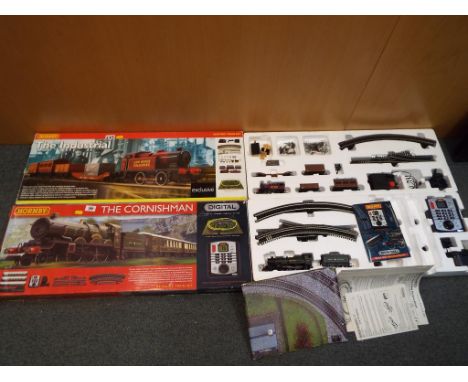We found 7940 price guide item(s) matching your search
There are 7940 lots that match your search criteria. Subscribe now to get instant access to the full price guide service.
Click here to subscribe- List
- Grid
-
7940 item(s)/page
AN IMPRESSIVE SILVER BOX HAVING CONNECTIONS TO THE VIVIAN FAMILY OF SWANSEA, WITH SWANSEA'S INDUSTRIAL PAST & WITH PIONEERING LOCOMOTIVE ENGINEERING The box having a light wood interior in three sections, with glass base and being of sarcophagus-form. The hinging lid mounted with a finely detailed model of a Garratt-type locomotive train on a section of track. The facade bearing the diamond-shaped logo for Beyer Peacock & Co Ltd, with Art Deco handle and twin floral diamond shaped cartouches to the sides. The lid inscribed 'Presented to Hugh Vivian, Chairman Beyer Peacock Group of Companies 1937 to 1949, 10th May 1949' and bears signatures of nineteen company members to the body. The body, lid, train and track all with marrying hallmarks for Walker & Hall, Sheffield 1948, 35cms wide x 19.5cms high x 15cms deep The box comes with a specially built carry-case with gilded lettering 'HV'. Background: Hugh Vivian was a member of the industrialist Vivian family of Swansea - the most notable descendant being Richard Glynn Vivian, founder of the Glynn Vivian Art Gallery. Hugh Vivian was Managing Director of Vivian & Sons Ltd, a Swansea Valley metals and chemicals company originally operating from Hafod Smelting Works & Mills. At one time in the nineteenth century, production from the site represented a quarter of the entire UK copper trade. Vivian & Sons traded from 1810 until 1924 when they then merged with two other Swansea companies to form British Copper Manufacturers Ltd. In 1928 the company was then absorbed by the conglomerate ICI and copper continued to be rolled from the Swansea sites until 1980. In 1923, under Hugh Vivian's directorship, the company ordered the first Garratt locomotive from Beyer-Peacock for British industrial service. Vivian later became Chairman of Beyer Peacock from 1937 to 1949 The Garratt-locomotive, developed by Herbert William Garratt, was a steam-locomotive that was articulated into three parts with the boiler mounted on the centre frame and twin steam engines on separate frames - one on each end of the boiler. The enhanced articulation enabled the trains to negotiate curves easier where larger rigid-framed locomotives would struggle. The Garratt-locomotives were built by Beyer Peacock and commissions were gained across the world, most notably in Africa, Australia and USSR. Provenance: the box was purchased by the present vendor in the 1970s at an auction of Hugh Vivian's chattels after his death. Included with the item is a luncheon menu commemorating Hugh Vivian Esq and his involvement with Beyer Peacock and the commissioning of the aforementioned engine, held at The Dorchester Hotel, London on May 10th 1949 Condition Report: complete without any notable bumps or dints, slight surface scratches, excellent well-looked after piece.
An Airfix Spitfire model kit, a Mini-Rama, a Micro Machines James Bond 007 set, Crookes Healthcare set, two military vehicles, a wooden train, fifteen petrol pumps, a toy Shell garage, an AA badge, a Trik Trak Cross Country Road Rally, an Aurora Formula 1 Duel racing game and empty model vehicle boxes
A rare Charles II brass miniature striking lantern clock with alarmBy Joseph Knibb, London, circa 1670, and with some elements replacedSurmounted by a turned finial, above quatrefoil pierced petals and four straps above the bell, the posted frame with three pierced and engraved dolphin frets, the front fret inscribed to the base 'Iofeph Knibb Londini', each continuous pillar with integral finial and foot, cast as one piece, the dial with 3 ⅜ in. narrow silvered chapter ring, engraved with quarter and fleur-de-lys half-hour markers, engraved to the centre with foliage, the silvered alarm disc with 'sunburst' engraving and single blued steel hand, the movement with re-converted verge escapement, bob pendulum and countwheel strike, with alarm train, steel back, iron hoop and a pair of brass doors, on turned feet, with later replaced elements.23.5cm. high. IllustratedThis is probably one of the earliest examples of Joseph Knibb's lantern clocks, following his move to London from Oxford, and displays a number of singular features which underline his authorship. In the narrow chapter ring he uses half hour divisions, which are similar to several table and longcase clocks made circa 1671-73. The dial is finely engraved and bears traces of fire gilt. The alarm disc is engraved with Arabic numerals, and the sunburst to its centre is possibly unique to Knibb. The columns are cast in one piece, with integral baluster finials and rounded feet. It also has his pattern bell strap.A virtually identical lantern clock of the same size, by Knibb, was sold at Sotheby's, London, 2nd November 2011, lot 24. Ronald Lee illustrates this clock in his seminal book The Knibb Family Clockmakers, plate 174, p. 161. It is signed on the dial, whilst on the opposite page, plate 173, is an example signed on the fret John Knibb and dated 1669. In his book English Lantern Clocks, Figure V/111, p. 258, George White illustrates another example of the same model signed Joseph Knibb, Oxford. It appears to be signed on the fret - having the extra narrow band on its base for the signature line - as has the lot offered here. An example, signed John Knibb, Oxon, is in the Museum of the History of Science, Oxford. Signed on the dial, it has the same front fret design, including the narrow signature band, but with hatched engraving along it. Joseph Knibb, a celebrated member of the cadre from the Golden Age of Clockmaking, was born in 1640 at Claydon, Oxfordshire. He was apprenticed to his cousin Samuel in Newport Pagnell circa 1655. In 1662 Samuel moved to London and Joseph moved to Oxford where he set up premises in St. Clement's, outside the city. Around 1665/6 he moved to Holywell Street, within the city bounds. Once his business was inside the city walls, Joseph faced a level of opposition to becoming a Freeman of the City, finally granted to him in 1668. In 1670 he moved to London, most likely to take over his cousin Samuel's workshop, following his death. Admitted to the Worshipful Company of Clockmakers, he set up business at the Dyal, near Serjeant's Inn in Fleet Street. He was elected as a Steward of the Clockmakers' Company in 1684 and Assistant in 1689. He retired in 1697 and went to live at his estate in Hanslope, Buckinghamshire, where he died in 1711.COMPARATIVE LITERATURE:Ronald Lee, The Knibb Family Clockmakers, Byfleet, 1964, pages 157-162.George White, English Lantern Clocks, Woodbridge, 1989, pages 257-263 and 365.
LOT OF MODEL VEHICLES, BOATS, TRAINS AND SOLDIER FIGURESincluding Tri-Ang Stephenson's Rocket '00' Scale model train, Seaforth Highlanders eleven pieces limited edition collectors models of British Soldiers and assorted die-cast model vehicles in original boxes including Majorette, Promoters, Leyland and a Clydeside Waterline model of the H.M.S. Emerald CL. 1939
Model Railways - A good lot to include a large quantity of 0 gauge model railway toys to include a Hornby clockwork train set No 501 in original box. A Mettoy Railways 0 gauge passenger train set in original box, a further Hornby 0 gauge clockwork train set and a quantity of accessories all by Hornby Trains to include a Goods Van, Flat Truck with Container, Coach, Side Tipping Wagon, Rotary Tipping Wagon, Goods Platform, Water Tank and Petrol Tank Wagon.
-
7940 item(s)/page



























































